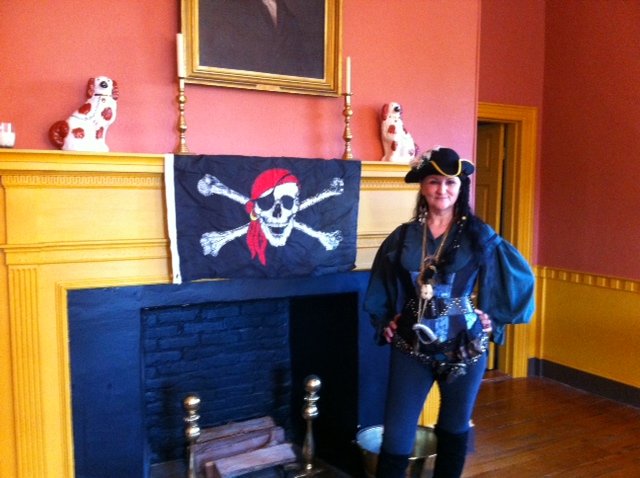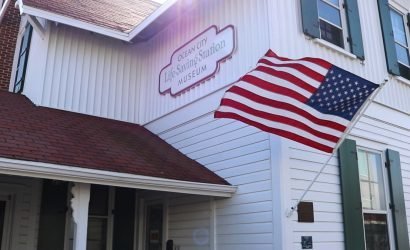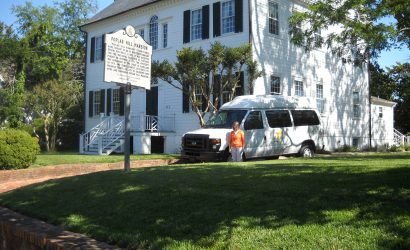Ahoy there, untie yer ship and set sail for Salisbury’s Poplar Hill Mansion! In celebration of national “Talk Like a Pirate Day,” Poplar Hill Mansion hosted a lecture last week on “Pirates of the Delmarva Coast.” Curator Sarah Meyers spearheaded the event, noting that she felt it was an important topic to speak about, “because most people think of pirates in the Caribbean and they see them as a fantasy. However, there’s a real connection between the Eastern Shore and the many pirates that visited here.” ShoreBread took advantage of the opportunity to tour Salisbury’s oldest home while also learning about how Pirates affected our local shores.
Poplar Hill is a Federal Style building, which means that it was constructed during the American Revolution era. Construction for Poplar Hill began in 1795 when Major Levin Hardy bought the plot of land. He was related to the same family that owned the neighboring plantation Pemberton Hall. However because of Handy’s medical bills, he could not afford to complete Poplar Hill. The title was passed to the physician Dr. John Huston who moved in and completed the mansion with his family. When the doctor died in 1828, his widow Sarah inherited the estate.
Sarah Huston began subdividing plots of Poplar Hill’s land and oversaw the lay-out of the area’s streets. Elizabeth and Isabella streets were named after her daughters, forever imprinting the legacy of the Hustons. As time passed, the neighborhood was built up around Poplar Hill and its land was slowly subdivided. Today, the historical landmark stands on Elizabeth Street and provides visitors with a peek into the past. Tours are offered by appointment or for free on the first and third Sundays of each month with the exception of the month of January.
If paranormal adventure interests you, Poplar Hill has multiple other-worldly inhabits. Rumor has it that one ghost was a house slave whose skirt caught on fire in the nursery, badly burning her leg. She later died from the burn’s infection and is known to still have a presence in the mansion. Friends of Poplar Hill hired a psychic who discovered angry run-away slave spirits in the home’s cellar. The nursery is also home to a rocking chair that can be found facing a different direction than it was previously arranged. There was so much spiritual activity surrounding the crib, that the display dolls were removed because they were often mysteriously rearranged.
After getting a crash course on Poplar Hill’s paranormal activity, we headed downstairs, away from the ghosts, to join audience members for a discussion of pirates on our local shores. We quickly learned that the pirate Golden Age – which ran from 1690-1740 – first began in tropical regions, such as the Caribbean. They spread farther North to the East Coast when the British Navy began pursuing them. Pirates especially liked the Eastern Shore because of the many inlets, coves, and waterways that allowed easy escapes and hiding places. Local towns that were favorite pirate stopping points included Vienna, Maryland and Lewes, Delaware.
One of the first acts of piracy in America occurred in the 1630’s when William Claiborne set up a trading post on Kent Island. Here he made a fairly decent profit due to his strategic location. However, Kent Island had recently switched from being Virginia territory to becoming part of Maryland when it was purchased by Lord Baltimore. Because of the change of power, Claiborne would need to purchase a new trading license. Claiborne decided to take a more frugal method and continued to use his license from Virginia. The authorities eventually punished him for his infringement and charged him of piracy. Luckily this local Eastern Shoreman got out of his crime and did not receive harsh punishment.
A well-known pirate that often visited the Eastern Shore was the infamous Black Beard. He was a merciless pirate who ravaged countless towns. He did however have a favorite town in Delaware that he often stopped in to have his boat cleaned. This town was saved from his despair because his crewman’s family lived there. People in the area liked Black Beard so much that they named a town and creek, now called Blackbird creek, after him. There are also places in Virginia and Maryland called Teach Island that are named after Black Beard’s real last name.
Black Beard’s connection with Delmarva is one of the few positive points in Black Beard’s reputation. He was known as the most feared pirate on the seas. He would use scare tactics such as sparklers in his hair and red ribbons in his beard to look like blood in order to terrify his victims. He also had fourteen wives that he visited at different ports. Black Beard’s demise is fitting for his bloody reputation. It is said that Black Beard had retired to Ocracoke, North Carolina where he sat on the beach and reminisced on his pirate days. He then decided to have a comeback tour of sorts, reviving his pirate ways for a short time, until the governor had the navy attack Black Beard’s ship. The captain of the governor’s ship eventually engaged in sword combat with Black Beard. As the legend says, the feared pirate was stabbed twenty times, shot six times, and beheaded. However he did not die until his body threw itself overboard, swam around the ship three times and then ventured off into the distance.
Another well-known pirate discussed at Poplar Hill was William Kidd. He was originally a business man who became a privateer, hired by the British government to hunt pirates. However, his mutinous crew persuaded him to engage in piratical activities causing him to switch to the dark side. This turned into a tragic voyage for Kidd because he was eventually caught and tried in British court. He was given the death sentence and hanged. William Kidd’s tale lives on as the only known pirate to bury treasure. Although it is assumed all pirates did this with their booty, Kidd’s is the only treasure we can prove was from a pirate. Because there are documents of his handwriting from his prior business practice, historians can prove that the treasure found near Long Island belonged to him.
Pirates also helped shape American history, having notable influence on how Delmarva developed. For example, Delaware was once the three lowest counties belonging to Pennsylvania. Although the towns were constantly ransacked by pirates, they could not defend themselves because of Quaker pacifistic laws. In order to save their homes and economy, the people pulled away from the Quaker State. There was also an incident where three retired pirates, Davis, Waver, and Henson were brought to court because of their past crimes. They pleaded their case and received a lesser punishment of paying one hundred pounds each to the British government. This large amount of money was later used to help build the College of William and Mary. There was also a period of time when pirates that were paid by the government to plunder enemy ships. These privateers were often used in the American Revolution and helped our country win independence from Britain.
Like the privateer, there were a wide variety of names for the different types of pirates. Picaroons were the British version of a privateer and Buccaneers were French land pirates. Mooncussers were a purely American term, referring to pirates that used tricks to run a ship into land and steal its booty. One way Mooncussers accomplished this was by building a large sand dune and standing on top with a fire inside a barrel. By opening and closing the barrel, the light appeared to be a light house from the ocean. Ships would steer towards the supposed lighthouse, believing it to be another waterway and end up crashing into shore. Mooncussers also accomplished this by tying a lantern around a mule’s neck and walking back and forth. These pirates could not do their dirty work when the moon was out however because they could be seen by the approaching ships. They would cuss at the moon as a result, hence the nickname, Mooncussers.
After a night filled with hauntings and pirate lore, we walked out of Poplar Hill and back into the modern world with a greater knowledge and appreciation of the influence pirates had here on the Eastern Shore. As we looked back at the mansion in the twilight, we hoped no spirits were looking back at us, but we realized it would be a great place for Halloween party. ShoreBread gives this landmark a thumbs up for a great history lesson and if anyone does host a Halloween event there, please remember to give us an invite.









